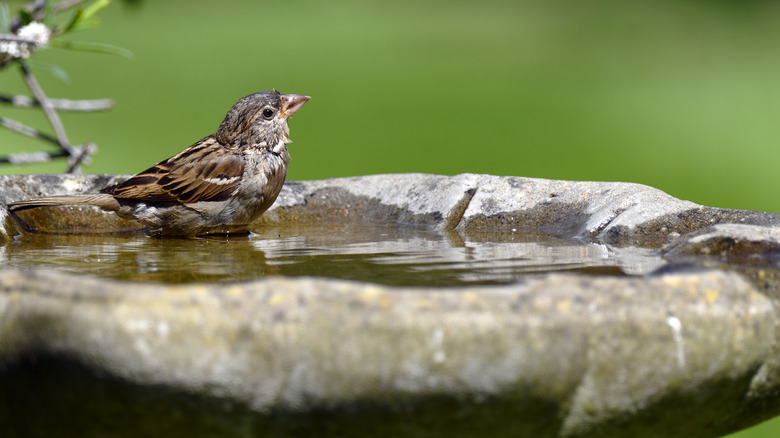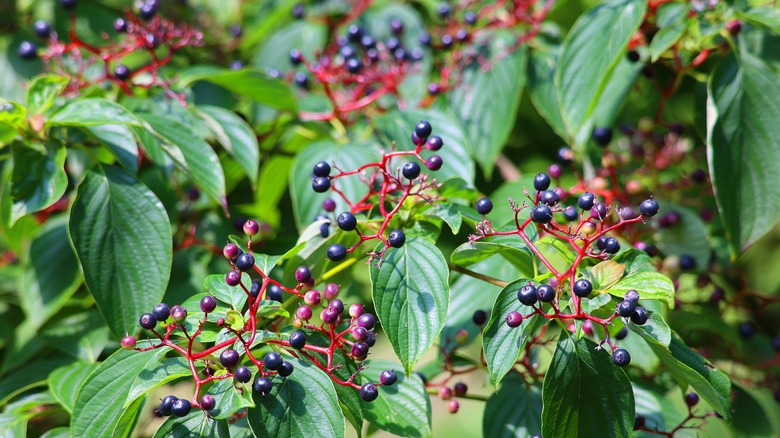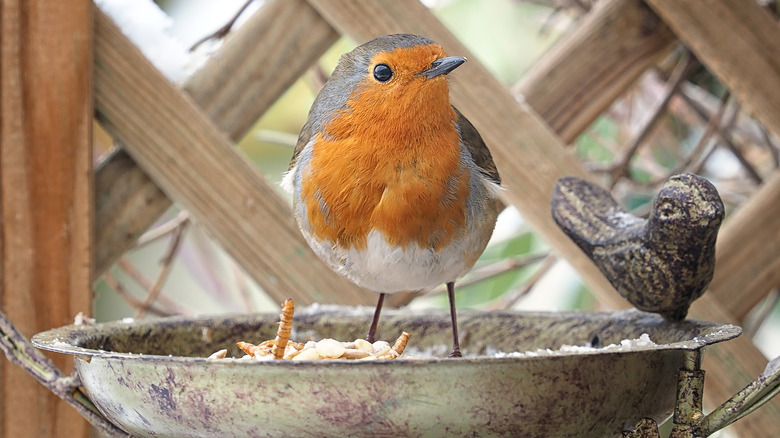10 Simple Hacks To Get Birds To Flock To Your Yard
We may receive a commission on purchases made from links.
Attracting birds to your yard isn't just about adding beauty to your garden; it has practical and ecological benefits. Many types of birds can serve as little helpers in your garden. They help maintain garden health by eating unwanted insects and pests like aphids, earwigs, and beetles. They also aid in pollinating plants, and spreading seeds, which aids in preserving biodiversity. Their presence can turn any backyard into a mini-ecosystem, inviting a sense of wonder and sparking an appreciation for wildlife. Beyond this, a yard filled with birds provides educational opportunities for families, allowing children and adults alike to observe different species and learn about their natural behavior right at home.
Birding—a more active alternative to birdwatching—has also been shown to provide mental health benefits. A study published in 2024 in Ecopsychology found that birders report lowered anxiety and stress, which means that more birds in your yard could turn your space into a sanctuary for relaxation. Even if you're not actively seeking out certain bird species and studying them, observing birds from a window or on your porch can add a sense of tranquility to the average person's daily routine. And, with the right approaches, you can attract a variety of species to make your garden a vibrant, lively space. From selecting the right feeders to providing fresh water and offering high-quality food, these simple tips can transform any yard into a bustling bird paradise. Let's dive into each hack and discover how to create a welcoming environment for birds.
Select high-quality birdseed
Not all bird feed is created equal. High-quality seed options are essential if you want to keep birds coming back. Invest in seed mixes that include sunflower seeds, nyjer seeds (thistle), and millet—these are favorites among many birds and provide essential nutrients. Try to avoid mixes with filler seeds like milo or wheat, which birds often discard, creating waste.
For even better results, offer a variety of food types beyond seeds, such as cracked peanuts or cracked corn. Simply adding a few of these kitchen staples to your feeder will have birds flocking to your yard. These can attract specific species like woodpeckers and jays, further enhancing your yard's avian diversity. Fresh, high-quality food ensures that birds get the energy they need, especially during migration or breeding seasons when nutrition is critical.
An important aspect of bird feed is also keeping it fresh. Regularly clean and refill feeders to prevent mold, which is extremely harmful. Busier feeders should be cleaned more regularly to prevent the spread of bacteria. On the flip side, if you find that bird feed is constantly left behind and spoiling, this may warrant changing out your feed mix with other types of feed that are more attractive to the birds in your area. Local wildlife organizations, birdwatching groups, or garden centers can help inform you of the best bird feed choices for attracting the right birds in your area.
When storing bird feed, always keep it in a dry, cool place to avoid spoilage and prevent attracting pests. Airtight containers work well for maintaining freshness and deterring unwanted animals.
Choose the right birdfeeders
Choosing the correct type of feeder is essential for attracting different bird species. Some birds, like finches, prefer tube feeders, while suet feeders are great for insect-eating birds like woodpeckers and nuthatches. Providing a variety of feeders ensures you cater to different species' preferences, attracting a more diverse bird population. You can even transform a soup can into a stunning birdfeeder!
It's also important to consider what species of birds are native to your area. It doesn't make sense to set up a feeder for birds that don't frequent your region. Research the common species in your area to understand what types of feeders they prefer, and over time, observe the bird behavior in your garden to help you refine your setup.
Feeder placement matters, too. Position feeders strategically. This means that they should be close to natural shelter, like near bushes or trees, where birds feel safe from predators. Of course, you will want the birds to be visible enough for you to enjoy the view. The Canadian Wildlife Health Cooperative suggests a maximum distance of about 11½ feet from cover as ideal. Avoid placing feeders too close together, too. Overcrowding can lead to competition and stress among birds.
Investing in sturdy, weather-resistant feeders, like the Nature Anywhere Transparent Acrylic Window Birdfeeder from Amazon, can also prevent issues like mold or rust, keeping food fresh and healthy for the birds. Plus, choosing high-quality feeders will reduce maintenance needs, which will be more cost-effective in the long run.
Place feeders at varying heights
Many bird species, like sparrows, doves, and juncos, are natural ground foragers are ground foragers, meaning they prefer to feed directly off the ground rather than from elevated feeders. Adding ground feeders is an effective way to attract these types of birds, as it caters to their instinctive feeding habits. Therefore, it will also bring them closer to your yard as opposed to only having hanging feeders. Even simply scattering seeds on the ground is a way you can account for birds with ground feeding preferences.
While ground feeding is preferred by some birds, having a food source on the ground can also attract other wildlife, such as squirrels, raccoons, or even larger animals, depending on your location. This is why some gardeners will opt to use low platform feeders. This setup keeps seeds elevated and protected from pests, but still accessible for ground-feeding birds. Like other birdfeeders, cleaning platform feeders is still essential, as leftover seeds and hulls can create an environment where pathogens thrive, which could potentially harm visiting birds.
When it comes to your hanging feeders, placing them at different heights reduces crowding and competition, creating a more inviting environment for all visitors. Birds of varying sizes will feel more comfortable, leading to a diverse array of species in your yard.
Set up a feeding schedule
On the topic of bird food, consistency is key when it comes to feeding birds. It not only encourages them to return but also supports their overall health, especially during breeding and migration seasons when birds spend extra energy. Birds quickly recognize reliable food sources and will return to feeders that are regularly filled. This is especially true in colder months, when food is scarce.
Set up a schedule to refill feeders consistently, ensuring they don't go empty for long periods. This consistency helps birds develop a routine and encourages them to view your yard as a dependable food source.
Observing feeding patterns in your yard can be a helpful strategy to accomplish this. Certain species may prefer to feed at specific times. Once you learn it, you can set up a refill schedule that aligns with their natural feeding habits. Doing so increases the chances of attracting a greater number of birds. Consider installing a bird camera to monitor activity and identify which times are most popular for different species. Some bird monitors, like the PUC Bird & Soundscape Monitor, are even advanced enough to track bird songs and calls. Others serve two birds with one stone, like this Smart Birdfeeder with Camera, which simultaneously feeds and identifies bird species that use it. These tools can be very helpful for establishing a feeding and cleaning schedule in your yard.
Provide fresh water
Water is just as important as food when attracting birds to your yard. Birds need fresh, clean water for drinking and bathing, which helps them stay hydrated and keep their feathers in top condition. Adding a birdbath or shallow dish is a simple way to provide a water source that birds can easily access.
When choosing a birdbath, select one that's large enough for multiple birds to simultaneously drink and bathe in comfortably. Shallow basins, ideally 1-2 inches deep and at least 18 inches across, are safer and allow even small songbirds to bathe with ease.
Like your birdfeeder, position your birdbath in a partially shaded area, ideally near bushes or low trees, so birds can find quick cover from predators while still feeling safe enough to bathe and drink. Once installed, maintaining your birdbath is essential. Replacing the water every few days is essential, as stagnant water can attract mosquitoes or algae, which may deter birds. If the bath is getting a lot of use, you may need to replace the water more frequently. You should also clean the birdbath regularly using environmentally safe soaps.
Moreover, you can add a small fountain or dripper to keep the water moving. Moving water reflects light, which draws birds' attention and creates a natural sound that many species find attractive. In winter, consider a heated birdbath to prevent the water from freezing. This way, birds have access to fresh water all year, which is especially valuable during colder months when natural water sources may be scarce or harder to access.
Add nesting boxes
Nesting boxes, also known as birdhouses, are small, enclosed shelters designed to mimic the natural nesting sites birds use in the wild, such as tree cavities or dense shrubs. They provide a safe place for birds to lay eggs and raise their young, protecting them from predators and harsh weather. By adding nesting boxes to your yard, you encourage birds to breed and settle in your outdoor space.
Different birds have specific nesting preferences, so it's essential to choose nesting boxes suited to the local birds you want to attract. For example, wrens prefer smaller entrance holes while larger species like woodpeckers need more spacious boxes. Proper placement is also key—hang nesting boxes in quiet, sheltered areas away from heavy traffic and from birdbaths and feeders, which may attract large communities of birds.
To ensure the boxes are functional and comfortable, make sure they have adequate ventilation and drainage holes to prevent moisture buildup and overheating. On the other hand, avoid placing boxes in direct sunlight, especially in the summer, as this can make the interior uncomfortably warm.
Between nesting seasons, clean out the boxes. These seasons vary by region and bird species, but for most songbirds in North America, the primary nesting season typically falls between early spring and late summer. This makes early fall an ideal time for cleaning out nesting boxes. Cleaning them out is helpful because it removes old nests, which could harbor parasites or mold, making the boxes more inviting for the birds to return the next nesting season.
Offer suet in the fall and winter
For the birds that don't migrate far south when the seasons turn crisp, suet is an excellent high-energy food source, during fall and winter when birds need extra calories to endure colder temperatures. Suet cakes, which are made of animal fat mixed with seeds, nuts, and fruit, are popular with insect-eating birds like woodpeckers, chickadees, and nuthatches, so offering this is a clever way to attract bug-eating birds to your yard. This energy-dense food can help birds survive colder months and encourages them to stay close to your yard, providing reliable nutrition when other food sources are scarce. To attract a variety of bird species, consider providing suet cakes in different flavors or mixes. You can even create your own DIY suet cakes.
If winters are mild in your region, opt for no-melt suet varieties specifically designed to withstand warmer temperatures. This way you'll avoid the unwanted odors and the potential mess that comes from softened suet and might deter birds from returning. A well-maintained suet feeder, with a variety of flavors to offer, can thus, turn your yard into a winter refuge for birds, making your garden a haven for them during the most challenging months of the year.
Reduce pesticide use
Reducing pesticide use is one of the simplest, yet most impactful ways to attract more birds to your yard. Pesticides kill off insects that birds sometimes rely on for food, especially during breeding season when they need extra protein to feed their young. By minimizing or avoiding pesticides, you're preserving a natural food source that draws birds to your outdoor space.
Healthy insect populations also contribute to a balanced ecosystem that supports other wildlife, like pollinators and small mammals, which indirectly benefits birds. Additionally, birds themselves act as natural pest control agents, feeding on insects such as aphids, caterpillars, and beetles that might otherwise damage your garden. The more birds you attract, the less likely it is that you'll need chemicals to manage pests.
Moreover, birds are sensitive to toxins in the environment. Pesticides can accumulate in their bodies, especially if they feed on contaminated insects or seeds, leading to health issues or reduced reproductive success. So, if the birds that flock to your yard aren't quite keeping up with the pesky insects in your garden, consider using natural alternatives like insecticidal soap. These solutions target unwanted pests without causing excess harm to birds or beneficial insects like bees and butterflies.
Plant native flowers and shrubs
Native plants are incredibly effective at attracting birds to your yard because they fit seamlessly into the local ecosystem. They provide food, shelter, and nesting sites that birds in your region instinctively recognize and utilize. Native plants are adapted to local wildlife and produce the seeds, berries, nectar and insects that local birds naturally eat. This is especially valuable because it supports both insect-eating and seed-eating birds.
Native plants also follow the rhythms of the local environment, producing foods at the times when birds need it most. For instance, berry-producing plants bear fruit in the late summer or fall, aligning with the migration season when birds need extra energy. In spring, many native flowers and trees produce nectar that is easy for birds to feed to their young.
Another bonus is that native plants are adapted to local soils and climate. Unlike exotic plants that often need extra watering or fertilizing, native plants will thrive in the environment as it is, reducing the burden you face as a gardener. This adaptation also means that native plants are typically more resistant to local pests and diseases, so they can grow strong and resilient with fewer resources.
Opt for bird-friendly yard design and decor
Using bird-friendly design can transform your yard into a haven where birds feel safe and protected. Common birds are delicate and need places to hide from predators, so creating natural shelter through decor and planting is essential. Birdhouses and nesting boxes play a key role here, offering safe spots for birds to nest and raise their young. Rather than leaving large open spaces, design your yard with clusters of plants, shrubs, and natural materials that mimic the dense cover birds seek in the wild. Thorny bushes, dense shrubs, and small trees provide excellent hideaways, allowing birds to retreat quickly to avoid predators or simply rest.
Adding natural perches can further boost the sense of security for birds visiting your yard. Untreated branches, driftwood, or sturdy wooden structures strategically placed near feeders or water sources offer convenient landing spots where birds can survey the area for threats and rest between flights.
To make the space feel even safer, try layering greenery and shrubbery at various heights (like with the feeders). This setup mimics the habitat that many birds prefer, as opposed to vast open spaces, encouraging them to stay in your yard and return season after season. By adding these elements, you'll create a sanctuary where birds can thrive and feel at ease, inviting them to come back and bring new life and beauty to your yard year after year.










